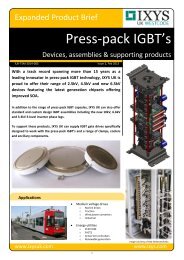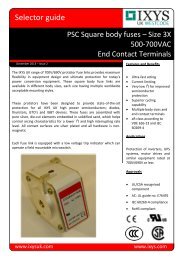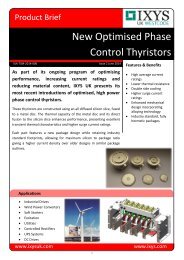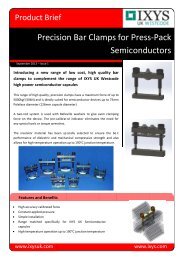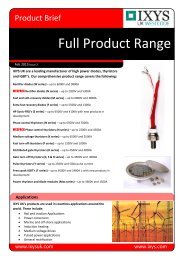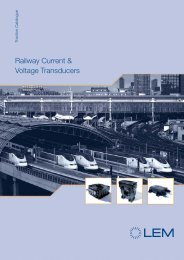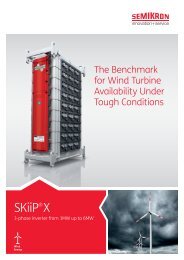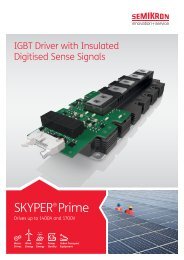isolated current voltage transducers
Create successful ePaper yourself
Turn your PDF publications into a flip-book with our unique Google optimized e-Paper software.
Fluxgate Technologies<br />
higher frequencies. Both secondary windings of T1 and T2<br />
also acts as the zero flux compensation winding, ensuring the<br />
transducer works in a closed loop mode.<br />
This design has the ability to supply a single coil (secondary of<br />
T1) with the „Fluxgate“ <strong>current</strong> (Fig. 32 and I µ<br />
in Fig. 34) as well<br />
as the secondary <strong>current</strong> (I S<br />
in Fig. 34) required for flux<br />
compensation. The processing electronics then removes the<br />
Fluxgate <strong>current</strong> in a „filter“ (ref. 2 in Fig. 34) to prevent noise<br />
at the transducer output. The output <strong>current</strong> (point C of<br />
Figure 34) is then equal to I S<br />
= I P<br />
• N P<br />
/N S<br />
. Finally, for a wide<br />
operating temperature range, the electronics are designed to<br />
automatically compensate the electronic offsets and <strong>voltage</strong><br />
drops, eliminating the need for adjustments.<br />
„C-type“ <strong>transducers</strong> internally control the loading of the<br />
secondary <strong>current</strong> and therefore have a <strong>voltage</strong> output.<br />
1<br />
Generator<br />
3<br />
Trigger<br />
T1<br />
A<br />
N S<br />
I S<br />
+I µ<br />
I µ<br />
I P<br />
N P<br />
B<br />
Figure 34: Block diagram of the C-type Fluxgate <strong>transducers</strong><br />
T2<br />
2<br />
Filter<br />
N S<br />
I S<br />
4.4.2 „CT-type“ <strong>current</strong> <strong>transducers</strong><br />
C<br />
4<br />
I/V<br />
Transducer<br />
5<br />
Control Loop<br />
Please note that „CT“ is a LEM product designation and is not<br />
used as an abbreviation for <strong>current</strong> transformer.<br />
The LEM „CT“ <strong>current</strong> <strong>transducers</strong> measure <strong>current</strong>s up to a<br />
maximum of 150 A. They typically have an accuracy of 0.1 %<br />
and a remarkable 0 to 500 kHz bandwidth.<br />
The main advantages are:<br />
• Excellent accuracy across the entire operating temperature<br />
range<br />
• Wide bandwidth<br />
• Extremely short response time<br />
• Excellent immunity to surrounding magnetic fields<br />
• High overload <strong>current</strong> capability (e.g. a CT 1-S transducer,<br />
with a 1 A nominal <strong>current</strong>, can withstand a overload above<br />
15 kA for 150 ms)<br />
• Output short circuit protection<br />
V M<br />
• Very high isolation levels and excellent resistance to<br />
partial discharge (e.g. CT 5-T/SP3 <strong>transducers</strong> have<br />
50 kVrms isolation with a partial discharge extinction level<br />
of 14.5 kV with < 20 pC)<br />
The limitation of the CT transducer is the injection of a<br />
rectangular <strong>voltage</strong> ripple on the primary line. This is caused<br />
by the Fluxgate excitation <strong>voltage</strong>, typically at a frequency of<br />
500 Hz, and is a function of the primary to secondary turns<br />
ratio. This primary <strong>voltage</strong> ripple induces a <strong>current</strong> noise,<br />
with an amplitude dependent on the primary circuit<br />
impedance; the lower the impedance the higher the <strong>current</strong><br />
noise (see calculation examples in § 4.4.6b). While this<br />
<strong>current</strong> noise is generally not a problem, it is measured by<br />
the transducer and will be seen as an additional<br />
measurement error.<br />
4.4.3 „CD-type“ differential <strong>current</strong> <strong>transducers</strong><br />
A LEM „CD“ transducer is designed to measure differential<br />
<strong>current</strong>s, the difference between two primary <strong>current</strong>s<br />
flowing in opposite directions. This application takes<br />
advantage of the very high sensitivity of this topology,<br />
allowing measurement of a differential <strong>current</strong> that is only<br />
0.1 % of the main <strong>current</strong> flowing in each primary conductor.<br />
For example, a differential <strong>current</strong> of 1 A can be measured<br />
with a main <strong>current</strong> of 1000 A, or 0.1 A with a main <strong>current</strong> of<br />
100A. The measurement accuracy is about 5 to 10 % within<br />
the specified operating temperature range.<br />
The main advantages are:<br />
• Very good differential resolution (able to measure low<br />
differential <strong>current</strong>s with high main <strong>current</strong>s)<br />
• Possibility to have an external adjustment by the user of<br />
the level of the differential <strong>current</strong> to be measured (a<br />
special design provides external terminals in the housing,<br />
where an adjustment resistor is connected)<br />
• Special designs allow the adjustment of the time constant<br />
of the measured differential <strong>current</strong>, which is convenient<br />
when the output signal of the transducer is used as a<br />
trigger in a safety system<br />
• Options to define several levels of differential <strong>current</strong>s to<br />
be measured (the transducer is then designed with a<br />
separate individual output for each <strong>current</strong> level)<br />
• Protection against primary <strong>current</strong> overloads<br />
The main limitations are:<br />
• Limited frequency bandwidth, typically DC to 2kHz<br />
• A differential <strong>current</strong> measurement should theoretically be<br />
independent of the main <strong>current</strong> value, but the main<br />
<strong>current</strong> must never exceed the transducer rated value to<br />
avoid permanent local saturation affects, due to both<br />
internal and external magnetic effects, which will reduce<br />
the accuracy of the transducer<br />
29





